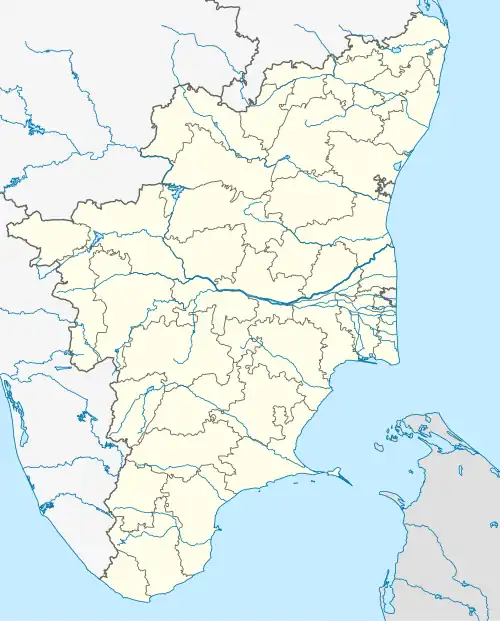Karamadai
Karamadai | |
|---|---|
 Karamadai Location in Tamil Nadu, India | |
| Coordinates: 11°14′34″N 76°57′31″E / 11.242800°N 76.958700°E | |
| Country | India |
| State | Tamil Nadu |
| District | Coimbatore |
| Area | |
• Total | 10 km2 (4 sq mi) |
| Elevation | 391 m (1,283 ft) |
| Population (2011) | |
• Total | 35,166 |
| • Density | 3,500/km2 (9,100/sq mi) |
| Languages | |
| • Official | Tamil |
| Time zone | UTC+05:30 (IST) |
| Postal Code | 641104 |
| Telephone Code | +91-4254 |
| Vehicle registration | TN-40 |
Karamadai is a municipality in Mettupalayam taluk of Coimbatore district in the Indian state of Tamil Nadu. Spread across an area of 10 km2 (3.9 sq mi), it had a population of 35,166 individuals as per the 2011 census. The Ranganathaswamy temple and Nanjundeswarar temple are prominent landmarks in the town.
Geography and administration
Karamadai is a municipality located in Mettupalayam taluk of Coimbatore district in the Indian state of Tamil Nadu.[1][2] Spread across an area of 10 km2 (3.9 sq mi), it was a panchayat town till 2021, when it was upgraded to a municipality.[2][3][4] It is located in the western part of the state.[5] The region has a tropical climate with hot summers and mild winters. The highest temperatures are recorded in April and May, with lowest recordings in December-January.[6]
The municipality is headed by a chairperson, who is elected by the members, who are chosen through direct elections.[7] The town forms part of the Mettupalayam Assembly constituency that elects its member to the Tamil Nadu legislative assembly and the Nilgiris Lok Sabha constituency that elects its member to the Parliament of India.[8]
Demographics
As per the 2011 census, Karamadai had a population of 35,166 individuals across 9,792 households.[1] The population saw a marginal increase compared to the previous census in 2001 when 27,817 inhabitants were registered. The population consisted of 17,557 males and 17,609 females.[4][9] About 3,056 individuals were below the age of six years.[1] The entire population is classified as urban. The town has an average literacy rate of 84.6%. About 14% of the population belonged to scheduled castes.[4][1] About 42.6% of the eligible population were employed full-time.[4][1]
Hinduism was the majority religion which was followed by 87.6% of the population, with Christianity (7.4%) and Islam (4.9%) being minor religions.[10] The Ranganathaswamy temple and Nanjundeswarar temple are prominent pilgrimage sites and landmarks in the town. The Ranganathaswamy temple is dedicated to Vishnu, and was built by the Cholas.[11] The Nanjundeswarar temple is dedicated to Shiva and his consort Parvati.[12][13]
References
- ^ a b c d e Geo level data: Census of India 2011 (Report). Census Commission of India. Retrieved 1 June 2025.
- ^ a b "12 town panchayats in TN upgraded as municipalities". The New Indian Express. 16 October 2021. Retrieved 1 June 2025.
- ^ "Town panchayats in Tamil Nadu" (PDF). Government of Tamil Nadu. Retrieved 1 June 2025.
- ^ a b c d "Karmadai". Citypopulation.de. Retrieved 1 June 2025.
- ^ "Coimbatore geographical setup". Government of Tamil Nadu. Retrieved 1 June 2024.
- ^ "Climate, Karamadi". Weather atlas. Retrieved 1 June 2025.
- ^ "Local Government". Government of India. p. 1. Archived from the original on 4 October 2022. Retrieved 1 January 2023.
- ^ Polling stations in Coimbatore district (PDF). Election Commission of India (Report). Retrieved 1 June 2025.
- ^ "Census of India 2001: Data from the 2001 Census, including cities, villages and towns (Provisional)". Census Commission of India. Archived from the original on 16 June 2004. Retrieved 1 June 2008.
- ^ Religion: Census of India 2011 (Report). Census Commission of India. Retrieved 1 June 2025.
- ^ S., Prabhu (2 May 2013). "With rich historical background". The Hindu. Retrieved 15 November 2015.
- ^ "Thirukoil - Temple list of Tamil Nadu" (PDF). Hindu Religious & Charitable Endowments Department, Government of Tamil Nadu. p. 507. Archived from the original (PDF) on 9 October 2020. Retrieved 29 August 2020.
- ^ Rajagopalan, M. (1993). 15 Vaishnava Temples of Tamil Nadu. Chennai, India: Govindaswamy Printers. pp. 114–5.